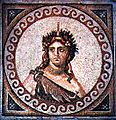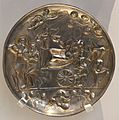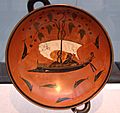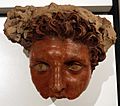Bacchus facts for kids
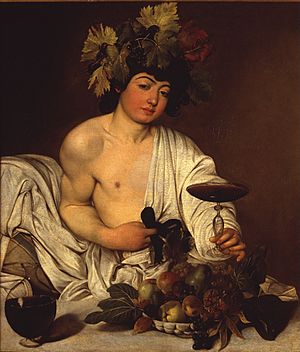
Bacchus was the Roman god of agriculture and wine, copied from the Greek god Dionysus. He was the last god to join the twelve Olympians; Hestia gave up her seat for him. His plants were vines and twirling ivy. He often carried a pinecone-topped staff, and his followers were goat-footed Satyrs and Maenads, wild women who danced energetically during his festivals.
Birth and childhood
Bacchus was the child of Jupiter (whose Greek name is Zeus) and Semele, a human whom Juno (whose Greek name is Hera) had tricked into asking to see Jupiter as he really was. Since she was a mortal, she was burned up by the sight of Jupiter in his divine form. So Jupiter sewed the infant Bacchus into his thigh, and gave birth to him nine months later. As a child, Bacchus was tutored by Silenus, who was a great lover of wine and often had to be carried on the back of a donkey. Before he took his place at Olympus, Bacchus wandered the world for many years, going as far as India to teach people how to grow vines.
Related pages
- Dionysus - Greek mythology version of Bacchus
Images for kids
-
Dionysus extending a drinking cup (kantharos) (late sixth century BC)
-
A Roman fresco depicting Bacchus with red hair, Boscoreale, c. 30 BC
-
The Conquest of India by Dionysus at the archaeological museum of Sétif, ca. 200–300 CE
-
Roman marble relief (first century AD) from Naukratis showing the Greek god Dionysus, snake-bodied and wearing an Egyptian crown.
-
Painted wood panel depicting Serapis, who was considered the same god as Osiris, Hades, and Dionysus in Late Antiquity. Second century AD.
-
Bronze hand used in the worship of Sabazios (British Museum). Roman first–second century AD. Hands decorated with religious symbols were designed to stand in sanctuaries or, like this one, were attached to poles for processional use.
-
Birth of Dionysus, on a small sarcophagus that may have been made for a child (Walters Art Museum)
-
Marble bust of youthful Dionysus. Knossos, second century AD. Archaeology museum of Heraklion.
-
Wall protome of a bearded Dionysus. Boeotia, early fourth century BC.
-
The Infant Bacchus, painting (c. 1505–1510) by Giovanni Bellini
-
Badakshan patera, "Triumph of Bacchus" (first–fourth century). British Museum.
-
North African Roman mosaic: Panther-Dionysus scatters the pirates, who are changed to dolphins, except for Acoetes, the helmsman; second century AD (Bardo National Museum)
-
The Triumph of Bacchus, Diego Velázquez, c. 1629
-
Hanging with Dionysian Figures from Antinoöpolis, fifth–seventh century (Metropolitan Museum of Art)
-
Bacchus - Simeon Solomon (1867)
-
The Dionysus Cup, a sixth-century BC kylix with Dionysus sailing with the pirates he transformed to dolphins
-
Bronze head of Dionysus (50 BC – 50 AD) in the British Museum
-
Statue of Dionysus in Remich Luxembourg
-
Terracotta vase in the shape of Dionysus' head (circa 410 BC) – on display in the Ancient Agora Museum in Athens, housed in the Stoa of Attalus
-
Amphora with cult mask of Dionysus, by the Antimenes Painter, around 520 BC, Altes Museum
-
Cult mask of Dionysus from Boeotia, fourth century BC
-
Marble statuette of Dionysos, early third century B.C, Metropolitan Museum
See also
 In Spanish: Dioniso para niños
In Spanish: Dioniso para niños






